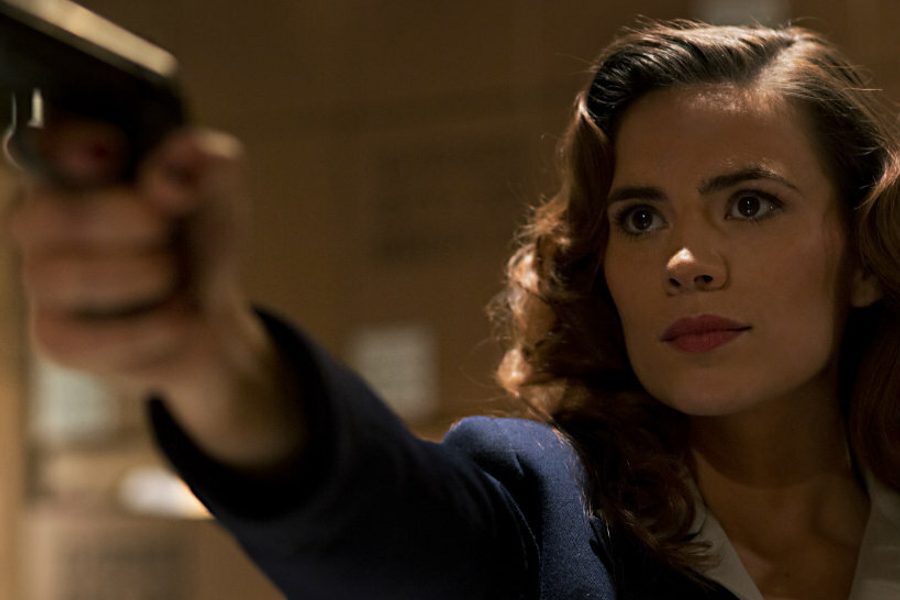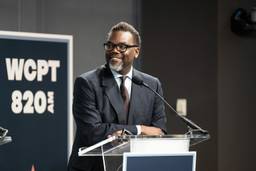Agent Carter’s ‘Feminism’ Is More About Making Money Than Gender Equality
Feminist, sexist, conservative, liberal—Marvel will give us any kind of superhero our heart desires as long as it makes them rich.
Jude Ellison Sady Doyle

On Tuesday evening, one thing was blowing up my entire Twitter feed: Agent Carter. It enchanted all my friends and critics I respected, and was hailed as a feminist revolution for the Marvel world. People were asking me, explicitly, to review it; I had to watch it.
The show itself? Not bad. Very smart, actually: It combines the current vogue for female empowerment via pseudo-historical fiction (Outlander, Game of Thrones, Mad Men) with a smart customer-retention strategy (filling the consumer demand for a female-driven Marvel project) with a built-in audience from a hot property (Captain America). It also manages to comport itself in a manner that is not obviously a cash grab, and to address — not to say “pander to” — feminist concerns.
And yet something nagged at me throughout the time I watched it — a sense that the show’s decent treatment of gender issues is less an earnest statement of the show runners’ personal values than a canny PR move on the behalf of pop-culture juggernaut Disney, owner of Marvel and, increasingly, just about everything else in the U.S. and global media landscape these days.
But first, the show itself: It’s 1946. World War II is over. Captain America is missing, presumed dead. Agent Peggy Carter (Hayley Atwell) is leaving the world of superheroics, and returning to work for the Strategic Scientific Reserve, where she is treated poorly. This coincides with women being pushed out of the workforce — which they had successfully claimed while the men were away at war — to give jobs to returning GIs. The parallel is duly noted, early in the pilot; a bit of feminist history is learned by all. Also, there are fabulous vintage outfits. Atwell looks splendid in them, and she can act, as well.
Soon, as the laws of comic book narrative dictate, a shadowy conspiracy of supervillains begins stealing superweapons. To retrieve them, Agent Carter must go undercover and/or above her sexist bosses’ heads. This requires a double life and a sidekick. (The sidekick is Jarvis, a British butler who was the eventual inspiration for the British-accented computer named JARVIS which runs Tony Stark’s mansion. This computer will be a central character in the next Avengers film. I can practically hear the product-integration guys moaning with pleasure as I type this sentence.)
It also requires a lot of scenes in which Carter punches the heck out of guys whose names we don’t know. Basically, it requires Agent Carter to become a superhero. And not just a superhero, but a feminist superhero! For we are given to understand that punching empowers Peggy greatly, and possibly empowers all womankind.
In one scene, a Captain America radio serial (yes, now even comic-book adaptations are set in a universe that contains comic-book adaptations) plays as the punches go down, contrasting the helpless, heavily fictionalized “Miss Carver,” (that is, she’s the fictionalized version of the fictional woman who is the “real” woman in the fiction we’re watching where people consume this fiction… oh, fuck it, she’s the one on the radio) begging for Captain America to rescue her with the “real” Miss Carter, who’s kicking ass on her own and can kill you with a fork.
It’s heavy-handed — and, in a re-telling, perhaps slightly confusing — but effective. The message here is, “Yes, comic book adaptations often reduce women to damsels in distress, but that’s over now. Look at Agent Carter.”
I can see why it’s worked for feminists and friends of mine. All of the social justice-oriented reviews of this show that I’ve seen have been positively glowing. It might have worked for me, too, in different circumstances. But I was keenly aware, at the time, that I wasn’t just watching a feminist superhero show — I was watching a Marvel Comics property branded as “feminist.”
Agent Carter’s feminist politics remind me of a trick consumer-goods people learned a long time ago: Take the same disposable razor, manufacture it in pink plastic instead of blue, and a family will buy it twice, because one of them is “for women.” Marvel has long been resistant to casting women in any roles other than “love interest”; we won’t see a female-led superhero movie until 2017 (Captain Marvel), nearly ten years after Iron Man kicked off the franchise. Even now, they’re testing the waters in the less expensive realm of TV before committing to a big launch. Things change a lot over the course of a decade, and now, there’s vocal consumer demand for more women in Marvel movies.
But that’s what this is: a strategy to retain consumers.
Demands for female representation are important, and I have made them about Marvel. But massive media corporations like Marvel (owned by Disney) have no real stake in the values of their media productions — they can’t afford to. Men and women, liberals and conservatives, all buy movie tickets, and it’s in Marvel’s best interest to make products that all those people will want to buy. And judging from the upcoming Marvel lineup, that’s the calculation the company is making.
Some, like the Iron Man franchise, will be male-oriented and overtly sexist, and some small minority, like Agent Carter, will be targeted to the female demographic and the ever-growing “feminism” trend — so popular among millennials!
Heck, Marvel already does this with political parties: Iron Man 2 is about a billionaire CEO who fights nobly to keep the government and the “liberal agenda” from restricting his business practices, and Captain America 2 is about a working-class veteran with PTSD who fights nobly against government surveillance, civilian profiling and drone warfare. These two franchises are so clearly targeted to Republicans and Democrats, respectively, that they might as well run against each other in 2016; why should Marvel start picking sides now?
And as goes Marvel, so goes the industry.
As Mark Harris writes in a sobering analysis of the movie industry at Grantland, comic-book movies have essentially determined the agenda for the entire film industry, and will do so for at least the rest of the decade. This cultural shift is more or less entirely due the success of Marvel’s Avengers franchise. All movies are trying to be Marvel movies. Marvel movies are trying to be television. And Marvel is making television (Agent Carter, Agents of S.H.I.E.L.D.) to fill in the gaps between movies.
Harris counts 32 comic book movies coming up in the next five years. Many will be continuations and expansions of the Marvel Cinematic Universe. Some will be from D.C. Comics, which is explicitly basing its franchise roll-out — movies about a single superhero (Man of Steel, 2013), then a superhero cross-over (Superman vs. Batman, 2016) then movies about superheroes introduced in the cross-over (Wonder Woman, 2017; Aquaman, 2018 ), and then on into unrelenting, orgiastic superhero-on-superhero action (Justice League, 2017, 2019, who knows how many or when after that) — on Marvel’s. They’ve also got their gender patterning down: Boys, boys, more boys, and then a lone Wonder Woman breaking up the monotony.
Sony and Fox bought two of the most famous Marvel properties early on (Spiderman and the X-Men, respectively), which prevents Disney from re-booting them. But don’t worry: We’ll be getting Spiderman and X-Men movies, too. Lots.
In fact, Marvel’s strategy of adapting properties with built-in audiences, then stretching the story out over dozens of products, has been so profitable that any major production is now expected to be split up and sequelized, and preferably to be an adaptation. When you add in the Star Trek/Star Wars/Divergent/etc. Marvel-esque adaptations and reboots we’ll be getting, that’s 70 franchise films in the next five years.
Given Marvel’s influence, yes, it’s good that Agent Carter has feminist ambitions, a strong female lead, even some understanding of women’s history. And that should be the standard for all Marvel movies, because, like it or not, they’re one of the most powerful cultural forces in the world. This is what the “representation” part of feminist analysis is good at demanding: If these entertainments are going to be ubiquitous, they had better not be harmful.
But let us not confuse a corporation adjusting its marketing strategy with “feminism.” Let us not assume Marvel wishes to do anything but acquire a new revenue stream, and let us not, dear Lord, commit the sin of gratitude for the bare minimum.
Because feminist ambitions or not, a win for Agent Carter is a win for an increasing consolidated media landscape, one in which a very few, very rich businessmen — almost all white, almost all men — claim a monopoly on our visual storytelling mediums, in order to tell the whole world one or two big stories that they personally control.
What gets squeezed out, when every movie is a Marvel movie, when every show is a Marvel show? It’s original stories. It’s creators who can set their own terms and speak in their own voices. (Marvel talks a big game about hiring quirky independent directors with vision, but they cut cult director Edgar Wright from his Ant-Man adaptation weeks before the movie started filming, after he had been working on the movie for eight years; any individual artist is a cog in the larger Marvel machine, and can be replaced instantly if they don’t toe the company line.) It’s marginalized people telling their stories, without having to squeeze their points in around the edges of the Walt Disney Company’s seven-year pre-constructed billion-dollar merchandise-integrated plotline.
The problem isn’t that Marvel has created a feminist show — it’s that, sooner or later, the only way to see a feminist show, or movie, might be to suck it up and watch something from Marvel, or something trying to be as much like Marvel as possible.
To get a sense of what the Walt Disney Company is after, through its Marvel subsidiary, take a look at how much of entertainment it already runs: If you look at the past year’s top-grossing movies in the US, four out of ten were made by either Disney or Disney-as-Marvel. If you look at the top-selling albums of 2014, two out of the top five were Marvel or Disney soundtracks: Guardians of the Galaxy is number five, and the Frozen soundtrack was #1 for most of the year until it was knocked into second place by Taylor Swift.
Factor in Disney’s record labels (including Hollywood Records, which focuses on “adult” music and owns pieces of powerhouse acts like Miley Cyrus and Selena Gomez) and they’ve got a substantial chunk of the music industry. Turn on the TV? If you land on any version of ABC, A&E, or ESPN, you land on Disney, and it might just be showing you Agent Carter or Agents of S.H.I.E.L.D. Books? Disney’s got them, ranging from children’s to YA. And then, of course, there are the comics.
Oh, and speaking of reading: Disney owns Grantland, too. You know, the place that published the great argument against comic-book movies.
Just like Marvel can give you Captain America for the blue states and Iron Man for the red, or Thor for dudes and Agent Carter for ladies, it doesn’t matter if you like comic book movies or hate them: All Disney wants is your eyes. While you’re reading and recommending the article about how Marvel ruined film, the website hosting the piece is collecting Disney-brand traffic that it can use to get money for Disney that it can use to make—whoops—more Marvel films.
Disney doesn’t have a stake in the political issues, but it does have a stake in funding the stories that return the most profits. If it can sneakily glean funding from the dissidents — whether by confiding in them about the evils of franchises or by catering to their resentment of sexism in comics — so much the better.
And then there are the clothing lines, the toys, the theme parks, the makeup lines, the bridal apparel. The Walt Disney Company doesn’t aim to be popular. It aims to be inescapable. There should not be a moment of your life, from cradle to wedding night to parenthood to grave, that you do not spend watching, listening to, reading, wearing, or visiting something that does not profit Disney.
Every entertainment experience should fund this one company, which will then use your money to make products you can’t help but buy. And once Star Wars comes out (yep: that’s Disney, too), it will be damn near impossible to avoid giving them that cash.
Such a company’s operations cannot be compatible with feminist goals. I don’t care if Disney is run by the ghost of Audre Lorde herself: The accumulation of disproportionate power (or total power) in the hands of an exorbitantly privileged few, who are not elected by the people, and who can set the agenda for a whole culture, is exactly what populist, egalitarian, left-wing movements oppose. Disney making “feminist” entertainments is a step toward Disney owning feminist entertainment, and thereby being able to set the terms for it.
This should scare you. Peggy Carter can kill a guy with a fork, and that’s “empowering,” but Disney is real power; massive power, which may be thoroughly impossible to resist.
Or, to put it in comic-book-movie terms: Feminism is an immensely powerful weapon, created by great heroes who knew how to use it wisely, which has fallen into the hands of a powerful international conspiracy of supervillains. We need to get it back, before they deploy it to achieve total world domination. Quickly, super-friends! To the tiny theaters showing independently funded documentaries! Before it’s too late!
Jude Ellison Sady Doyle is an In These Times contributing writer. They are the author of Trainwreck: The Women We Love to Hate, Mock, and Fear… and Why (Melville House, 2016) and was the founder of the blog Tiger Beatdown. You can follow them on Twitter at @sadydoyle.








